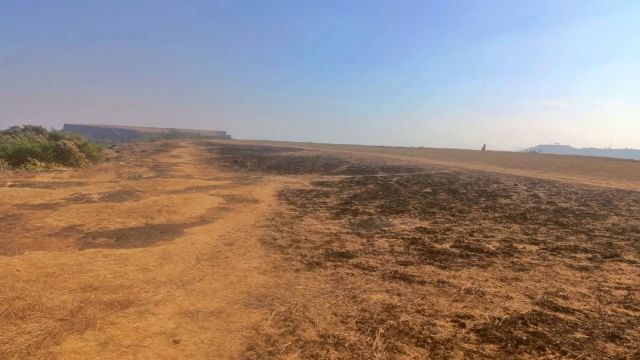Click here to join Express Pune WhatsApp channel and get a curated list of our stories
Protect the environment a challenge in tourist hub of Panchgani
At present, Patwardhan and the research team are battling another threat to the biodiversity– the municipality has dumped heaps of soil on the plateau and this has the potential to introduce seeds of weeds from other areas and suppress the natural flora.
 An image from this summer shows the effects of burning
An image from this summer shows the effects of burningIt is one of Maharashtra’s most vibrant scenic sites – and, thus, caught in the tug between tourism and the survival of biodiversity.
“The number of tourists that visit the plateau is higher than 10 to 15 lakh per year, which is a heavy pressure on the area. We see that, though tracks for horse rides are marked, horse owners stray from it. Even tourists walk around the plateau trampling on the flora. The seed sets of the many endemic species are threatened. There are instances of grass burning and species, such as Drosera burmanni and Adelocaryum malabaricum, are either showing population decline or total extinction from the local geography,” says Dr Ankur Patwardhan, a Pune-based researcher with Research and Action in Natural Wealth Administration.
At present, Patwardhan and the research team are battling another threat to the biodiversity– the municipality has dumped heaps of soil on the plateau and this has the potential to introduce seeds of weeds from other areas and suppress the natural flora. “The municipal council has agreed to remove the soil heaps before the monsoon. The dumping has been underway for the last eight months but, I am afraid, no action has been taken,” he says. Sudhakar Nangnure, chairman, State Level Monitoring Committee of the Mahabaleshwar-Panchgani eco-sensitive zone, told The Indian Express on Wednesday that, in the last meeting, instructions were given to remove the soil heaps from the 80 acres of the tableland.
 Dumping of soil in Panchgani
Dumping of soil in Panchgani
Fight to save microhabitat
Panchagani is home to very sensitive and fragile microhabitats. For more than a hundred years, scientists have been drawn to Panchgani because it is a “type locality” for six flowering plants – one of which is, possibly, extinct at present – and two species of freshwater fern that are endemic to the Western Ghats. A little-known facet of the Panchgani tableland is that it is the site of a complex restoration project since 2012 by the Ecological Restoration Alliance – India (ERA).
According to the ERA, “The area was rapidly losing its ecological and biodiversity values due to unrestricted and exploitative tourism, associated growth of illegal commercial recreation activities and neglect of various legal provisions to protect the area. Trampling and illegal use of heavy vehicles was eroding the microhabitats and slowly converting the plateau into barren wasteland, devoid of critical vegetation cover. Only a small area still retained the unique endemic plants, lichen and moss species, while fauna had reduced severely.” It adds that local authorities appeared unaware of the importance and the special features and, hence, did not follow any special management practice for the tableland.
Patwardhan was first looking at the diversity of tree species in the Mahabaleshwar and the Panchgani tableland, among others, when he became an official committee member of a high-level Monitoring Committee for the Eco-sensitive Zone of Panchgani and Mahabaleshwar in 2016. A few years later, he became chairman of the committee. A lengthy case in the Bombay High Court and the Supreme Court had resulted in the verdict that out of 100 acres, 80 should be conserved for the protection of endemic and endangered flora and fauna. The remaining 20 acres were for tourism and related activities. “But, the challenge was to demarcate the sensitive spots in the area and whether some of these can be cordoned off. Can we develop a micro plan for protection of the Panchgani plateau?” says Patwardhan.
A unique landscape
Panchgani, adds Patwardhan, is different from other protected areas. “It falls under the municipal council jurisdiction and, so, open to the public unlike other protected areas, such as wildlife sanctuaries and national parks,” he says. Yet, activities, such as redesigning of tourist movement, sensitisation of local guides on the environment and zoning of the area to carry out conservation, active restoration and sustainable use zones, are yielding results. Teams have been monitoring the area for vegetation recovery since 2012. “We also developed a short film regarding awareness of the critical and sensitive habitat and gave them to the municipal council,” says Patwardhan.
Other work includes studying the environmental parameters that shape the site’s diversity, from soil moisture content to temperature changes to the rainfall pattern. There is focus on documenting the species that are endangered and finding their pollinators and seed sets, among others.
“We are also looking at locally extinct species that used to be present 100 years ago, such as Vigna khandalensis, and where they can be found right now. We could reintroduce these, thus forming another successful model for recovery of those species,” says Patwardhan.
He adds that Panchgani could be a role model for other regions where biodiversity is under threat. “We need a responsible tourism promotion strategy. This includes literature about the ecological significance of the area, and clear do’s and don’ts of the area so that tourists don’t walk around plucking flowers but appreciate the species in the area,” he says.
Click here to join Express Pune WhatsApp channel and get a curated list of our stories








